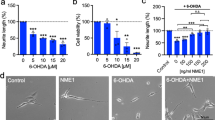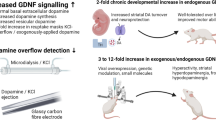Abstract
The neurotrophin growth/differentiation factor 5 (GDF5) is studied as a potential therapeutic agent for Parkinson’s disease as it is believed to play a role in the development and maintenance of the nigrostriatal system. Progress in understanding the effects of GDF5 on dopaminergic neurones has been hindered by the use of mixed cell populations derived from primary cultures or in vivo experiments, making it difficult to differentiate between direct and indirect effects of GDF5 treatment on neurones. In an attempt to establish an useful model to study the direct neuronal influence of GDF5, we have characterised the effects of GDF5 on a human neuronal cell line, SH-SY5Y. Our results show that GDF5 has the capability to promote neuronal but not dopaminergic differentiation. We also show that it promotes neuronal survival in vitro following a 6-hydroxydopamine insult. Our results show that application of GDF5 to SH-SY5Y cultures induces the SMAD pathway which could potentially be implicated in the intracellular transmission of GDF5’s neurotrophic effects. Overall, our study shows that the SH-SY5Y neuroblastoma cell line provides an excellent neuronal model to study the neurotrophic effects of GDF5.





Similar content being viewed by others
References
Abad F, Maroto R, Lopez MG et al (1995) Pharmacological protection against the cytotoxicity induced by 6-hydroxydopamine and H2O2 in chromaffin cells. Eur J Pharmacol 293:55–64
Akerud P, Alberch J, Eketjall S et al (1999) Differential effects of glial cell line-derived neurotrophic factor and neurturin on developing and adult substantia nigra dopaminergic neurons. J Neurochem 73:70–78
Bartus RT (2009) CERE-120 (AAV2-NTN) for Parkinson’s Disease: Review of Progress and Future Plans. American Society of Cell and Gene Therapy Meeting, San Diego
Berk AJ, Sharp PA (1977) Sizing and mapping of early adenovirus mRNAs by gel electrophoresis of S1 endonuclease-digested hybrids. Cell 12:721–732
Braak H, Del Tredici K, Rub U et al (2003) Staging of brain pathology related to sporadic Parkinson’s disease. Neurobiol Aging 24:197–211
Castelo-Branco G, Sousa KM, Bryja V et al (2006) Ventral midbrain glia express region-specific transcription factors and regulate dopaminergic neurogenesis through Wnt-5a secretion. Mol Cell Neurosci 31:251–262
Clayton KB, Sullivan AM (2007) Differential effects of GDF5 on the medial and lateral rat ventral mesencephalon. Neurosci Lett 427:132–137
Cookson MR (2005) The biochemistry of Parkinson’s disease. Annu Rev Biochem 74:29–52
Gasmi M, Brandon EP, Herzog CD et al (2007a) AAV2-mediated delivery of human neurturin to the rat nigrostriatal system: long-term efficacy and tolerability of CERE-120 for Parkinson’s disease. Neurobiol Dis 27:67–76
Gasmi M, Herzog CD, Brandon EP et al (2007b) Striatal delivery of neurturin by CERE-120, an AAV2 vector for the treatment of dopaminergic neuron degeneration in Parkinson’s disease. Mol Ther 15:62–68
Gill SS, Patel NK, Hotton GR et al (2003) Direct brain infusion of glial cell line-derived neurotrophic factor in Parkinson disease. Nat Med 9:589–595
Glinka Y, Gassen M, Youdim MB (1997) Mechanism of 6-hydroxydopamine neurotoxicity. J Neural Transm Suppl 50:55–66
Gomez-Santos C, Ambrosio S, Ventura F et al (2002) TGF-beta1 increases tyrosine hydroxylase expression by a mechanism blocked by BMP-2 in human neuroblastoma SH-SY5Y cells. Brain Res 958:152–160
Herzog CD, Dass B, Holden JE et al (2007) Striatal delivery of CERE-120, an AAV2 vector encoding human neurturin, enhances activity of the dopaminergic nigrostriatal system in aged monkeys. Mov Disord 22:1124–1132
Horger BA, Nishimura MC, Armanini MP et al (1998) Neurturin exerts potent actions on survival and function of midbrain dopaminergic neurons. J Neurosci 18:4929–4937
Hurley FM, Costello DJ, Sullivan AM (2004) Neuroprotective effects of delayed administration of growth/differentiation factor-5 in the partial lesion model of Parkinson’s disease. Exp Neurol 185:281–289
Kordower JH, Herzog CD, Dass B et al (2006) Delivery of neurturin by AAV2 (CERE-120)-mediated gene transfer provides structural and functional neuroprotection and neurorestoration in MPTP-treated monkeys. Ann Neurol 60:706–715
Krieglstein K, Suter-Crazzolara C, Hotten G et al (1995) Trophic and protective effects of growth/differentiation factor 5, a member of the transforming growth factor-beta superfamily, on midbrain dopaminergic neurons. J Neurosci Res 42:724–732
Lin LF, Doherty DH, Lile JD et al (1993) GDNF: a glial cell line-derived neurotrophic factor for midbrain dopaminergic neurons. Science 260:1130–1132
Liu Y, Rubin B, Bodine PV et al (2008) Wnt5a induces homodimerization and activation of Ror2 receptor tyrosine kinase. J Cell Biochem 105:497–502
Lopes FM, Schroder R, Junior ML et al (2010) Comparison between proliferative and neuron-like SH-SY5Y cells as an in vitro model for Parkinson disease studies. Brain Res 1337:85–94
Marks WJ, Verhagen Metman L, Starr PA, et al (2006) Trophic factor gene transfer in Parkinson’s disease: preliminary outcomes from the phase I CERE-120 study. American Neurological Association, 131st Annual Meeting, Chicago, IL
Mastroeni D, Grover A, Leonard B et al (2009) Microglial responses to dopamine in a cell culture model of Parkinson’s disease. Neurobiol Aging 30:1805–1817
Mayhew TM (1992) A review of recent advances in stereology for quantifying neural structure. J Neurocytol 21:313–328
McMillan CR, Sharma R, Ottenhof T et al (2007) Modulation of tyrosine hydroxylase expression by melatonin in human SH-SY5Y neuroblastoma cells. Neurosci Lett 419:202–206
Michel PP, Hefti F (1990) Toxicity of 6-hydroxydopamine and dopamine for dopaminergic neurons in culture. J Neurosci Res 26:428–435
Nishitoh H, Ichijo H, Kimura M et al (1996) Identification of type I and type II serine/threonine kinase receptors for growth/differentiation factor-5. J Biol Chem 271:21345–21352
O’Keeffe GW, Dockery P, Sullivan AM (2004a) Effects of growth/differentiation factor 5 on the survival and morphology of embryonic rat midbrain dopaminergic neurones in vitro. J Neurocytol 33:479–488
O’Keeffe GW, Hanke M, Pohl J et al (2004b) Expression of growth differentiation factor-5 in the developing and adult rat brain. Brain Res Dev Brain Res 151:199–202
Pahlman S, Ruusala AI, Abrahamsson L et al (1984) Retinoic acid-induced differentiation of cultured human neuroblastoma cells: a comparison with phorbolester-induced differentiation. Cell Differ 14:135–144
Pahlman S, Hoehner JC, Nanberg E et al (1995) Differentiation and survival influences of growth factors in human neuroblastoma. Eur J Cancer 31A:453–458
Patel NK, Bunnage M, Plaha P et al (2005) Intraputamenal infusion of glial cell line-derived neurotrophic factor in PD: a two-year outcome study. Ann Neurol 57:298–302
Rosenberg PA (1988) Catecholamine toxicity in cerebral cortex in dissociated cell culture. J Neurosci 8:2887–2894
Sammar M, Stricker S, Schwabe GC et al (2004) Modulation of GDF5/BRI-b signalling through interaction with the tyrosine kinase receptor Ror2. Genes Cells 9:1227–1238
Sammar M, Sieber C, Knaus P (2009) Biochemical and functional characterization of the Ror2/BRIb receptor complex. Biochem Biophys Res Commun 381:1–6
Slevin JT, Gerhardt GA, Smith CD et al (2005) Improvement of bilateral motor functions in patients with Parkinson disease through the unilateral intraputaminal infusion of glial cell line-derived neurotrophic factor. J Neurosurg 102:216–222
Storch A, Kaftan A, Burkhardt K et al (2000) 6-Hydroxydopamine toxicity towards human SH-SY5Y dopaminergic neuroblastoma cells: independent of mitochondrial energy metabolism. J Neural Transm 107:281–293
Storch A, Ludolph AC, Schwarz J (2004) Dopamine transporter: involvement in selective dopaminergic neurotoxicity and degeneration. J Neural Transm 111:1267–1286
Sullivan AM, Opacka-Juffry J, Hotten G et al (1997) Growth/differentiation factor 5 protects nigrostriatal dopaminergic neurones in a rat model of Parkinson’s disease. Neurosci Lett 233:73–76
Sullivan AM, Pohl J, Blunt SB (1998) Growth/differentiation factor 5 and glial cell line-derived neurotrophic factor enhance survival and function of dopaminergic grafts in a rat model of Parkinson’s disease. Eur J Neurosci 10:3681–3688
Sullivan AM, Opacka-Juffry J, Pohl J et al (1999) Neuroprotective effects of growth/differentiation factor 5 depend on the site of administration. Brain Res 818:176–179
ten Dijke P, Miyazono K, Heldin CH (2000) Signaling inputs converge on nuclear effectors in TGF-beta signaling. Trends Biochem Sci 25:64–70
Toulouse A, Sullivan AM (2008) Progress in Parkinson’s disease-where do we stand? Prog Neurobiol 85:376–392
Wood TK, McDermott KW, Sullivan AM (2005) Differential effects of growth/differentiation factor 5 and glial cell line-derived neurotrophic factor on dopaminergic neurons and astroglia in cultures of embryonic rat midbrain. J Neurosci Res 80:759–766
Acknowledgments
The authors would like to thank Dr Jens Pohl from Biopharm GmbH for the generous gift of GDF5, Dr Gerard O’Keeffe from University College Cork for his comments, and the Higher Education Authority (Ireland) for funding through the PRTLI3 programme.
Author information
Authors and Affiliations
Corresponding author
Rights and permissions
About this article
Cite this article
Toulouse, A., Collins, G.C. & Sullivan, A.M. Neurotrophic Effects of Growth/Differentiation Factor 5 in a Neuronal Cell Line. Neurotox Res 21, 256–265 (2012). https://doi.org/10.1007/s12640-011-9266-7
Received:
Revised:
Accepted:
Published:
Issue Date:
DOI: https://doi.org/10.1007/s12640-011-9266-7




